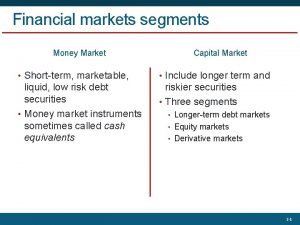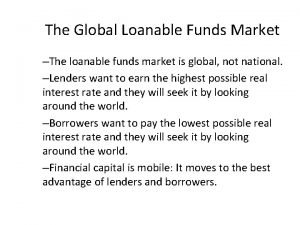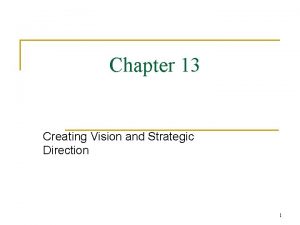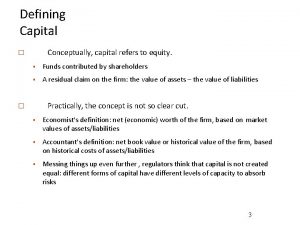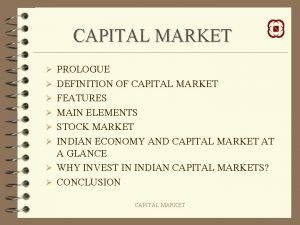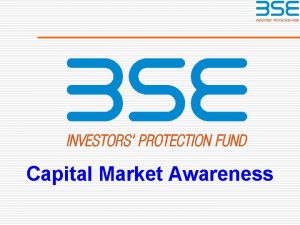CAPITAL MARKET Market for longterm funds focuses on






































































- Slides: 70

CAPITAL MARKET � � � � Market for long-term funds. focuses on financing of fixed investment channelizes household savings to the corporate sector and allocates funds to firms Enables the valuation of firms on an almost continuous basis and plays an important role Efficient capital market is an important element of a sound financial system A stock market deals mainly in corporate securities. The securities are chiefly in form of equity shares and debentures. The purpose of these securities is to raise long term funds for companies engaged in production.

Main Function of stock market To arrange for rising of new capital To provide liquidity to existing securities.

Interdependent and Inseparable segments of stock market

Primary market The securities issued in the primary market are issued by public limited companies or by government agencies. The resources in this kind of market are mobilized either through a public issue or through a private placement route

Primary market � q � � � If anybody can subscribe for the issue, it is a public issue if the issue is made available only to a select group of people, it is known as private placement. Two major types of issuers of securities: 1. corporate entities, who issue mainly debt and equity instruments 2. the government (central as well as state), which issues debt securities (dated securities and treasury bills)

Primary market � � � The bill market is a sub-market of the money market in India. There are two types of bills: Treasury Bills and commercial bills. While Treasury Bills or T-Bills are issued by the Central Government; Commercial Bills are issued by financial institutions.

Primary market � � � Treasury bills are instrument of short-term borrowing by the Government of India. It issued as promissory notes under discount. The interest received on them is the discount, which is the difference between the price at which they are issued and their redemption value.

T-bills(Treasury Bills)

Commercial bills

Types of Treasury Bills � � � � basically instruments for short term maturities less than one year Treasury Bills were first issued in India in 1917. At present, the active T-Bills are 91 -days T-Bills, 182 -day T -Bills and 364 -days T-Bills In 1997, the Government had also introduced the 14 -day intermediate treasury bills. Auctions of T-Bills are conducted by RBI. Individuals, Firms, Trusts, Institutions and banks can purchase T-Bills. The commercial and cooperative banks use T-Bills for fulfilling their SLR requirements.

Advantages of Treasury Bills � � � � � fulfill the short term money borrowing needs of the government Zero Risk weightage associated High liquidity because 91 days and 364 days are short term maturity Transparency The secondary market of T-Bills is very active so they have a higher degree of tradability. Issued only by the central government in India. The State governments do not issue any treasury bills. Interest on the treasury bills is determined by market forces. Treasury bills are available for a minimum amount of Rs. 25, 000 and in multiples of Rs. 25, 000.

Secondary market Secondary Market refers to a market where securities are traded after being initially offered to the public in the primary market and/or listed on the Stock Exchange. Majority of the trading is done in the secondary market. Secondary market comprises of equity markets and the debt markets.


BSE q q q Established in 1875, BSE (formerly known as Bombay Stock Exchange Ltd. ) It is Asia's first & the Fastest Stock Exchange in world with the speed of 6 micro seconds Over the past 140 years, BSE has facilitated the growth of the Indian corporate sector by providing it an efficient capital-raising platform BSE is a corporatized entity broad shareholder-base More than 5500 companies are listed on BSE making it world's No. 1 exchange in terms of listed members

BSE � BSE is the first exchange in India and second in the world to obtain an ISO 9001: 2000 certification Ø Demonstrate its ability to consistently provide product that meets customer and applicable regulatory requirements Ø Aims to enhance customer satisfaction through the effective application of the system, including processes for continual improvement of the system and the assurance of conformity to customer and applicable regulatory requirements.

BSE � It is also the first Exchange in the country and second in the world to receive Information Security Management System Standard BS 7799 -2 -2002 certification for its On-Line trading System (BOLT). � It operates one of the most respected capital market educational institutes in the country (the BSE Institute Ltd. ). � BSE also provides depository services through its Central Depository Services Ltd. (CDSL) arm.

NSE � NSE was promoted by leading Financial Institutions at the behest of the Government of India and was incorporated in November 1992 as a tax-paying company unlike other stock exchanges in the country. � NSE’s trading system, called National Exchange for Automated Trading (NEAT), is a state of-the-art client server based application. It has uptime record of over 99% with latency is in single digit millisecond level for all orders entered into the NEAT system. � Purpose � Committed to improve the financial well-being of people. Vision � To continue to be a leader, establish global presence, facilitate the financial well being of people.

NSE v � � � Values NSE is committed to the following core values : Integrity Customer focussed culture Trust, respect and care for the individual Passion for excellence Teamwork

Depository services � In order to promote dematerialisation of securities, NSE joined hands with leading financial institutions to establish the National Securities Depository Ltd. (NSDL), � It is the first depository in the country with the objective of enhancing the efficiency in settlement systems as also to reduce the menace of fake/forged and stolen securities. � The second depository in the country, CDSL promoted by the BSE and a few commercial banks, was granted certificate of commencement of business in February 1999.

Depository services � SEBI has made dematerialised settlement mandatory in an everincreasing number of securities in a phased manner, thus bringing about an increase in the proportion of shares delivered in dematerialised form

List of companies providing depository services in India � � � � � INDIA INFOLINE LIMITED J M FINANCIAL SERVICES PRIVATE LIMITED HDFC BANK LIMITED SHAREKHAN LIMITED KARVY STOCK BROKING LTD RELIANCE SECURITIES LIMITED MARWADI SHARES & FINANCE LIMITED KOTAK MAHINDRA BANK LIMITED MOTILAL OSWAL SECURITIES LIMITED

Difference between BSE & NSE No. BSE NSE 1 Established in 1875 1992 2 Name formerly Bombay Stock Exchange Limited; now simply BSE National Stock Exchange 3 Number of listed companies 5, 163 (as of late 2012) 1, 635 (as of July 2013) 4 Main Index BSE Sensex S&P CNX Nifty

Difference between BSE & NSE No BSE NSE 5 Claim to fame Oldest stock exchange in Asia. Largest stock exchange in India in terms of daily turnover and number of trades. 6 Website www. bseindia. com 7 Top trading TCS, reliance , ITC , ongc, companies infosys, coal india, hdfc bank in volumes in main index (Till March 2007) www. nseindia. com Reliance Industries Limited, Infosys Technologies Limited, .

Importance of capital market v v v Link between Savers and Investors Encouragement to Saving( Banking and non banking Institutions) Encouragement to Investment Promotes Economic Growth Stability in Security Prices ( Reduce speculative and unproductive activity)

India enters the elite club of world's 10 largest stock markets Rank Name of Country Name of stock exchange Percentage of world’s market capitalisation(2014) 1 United States New York Stock Exchange 37% 2 Japan Tokyo Stock Exchange 7% 3 China Shanghai stock Exchange 6. 5% 4 Hong Kong Stock Exchange 5. 9% 5 UK London Stock Exchange 5. 8%

India enters the elite club of world's 10 largest stock markets Rank Name of Country Name of stock exchange Percentage of world’s market capitalisation(2014) 6 Canada Toronto Stock Exchange 3. 3% 7 France Euronext stock exchange (Paris) 3% 8 Germany Frankfurt Stock Exchange 2. 8% 9 India Bombay Stock Exchange. (BSE&NSE) 2. 5% 10 Switzerland Swiss exchange 2. 4%

Factor affects investment pattern of investor Reliability and safety of investment 2. Return on Investment 3. knowledge and willingness to take risk (financial responsibilities, your environment, your basic personality ) 4. Past market trends 5. Investment horizon 6. Third party opinion 1.

Factor affects investment pattern of investor 7. Goodwill of the company 8. Accounting Information 9. Current trend 10. Demographic characteristics of Investor

Mehta and Aggarwal (2011) � � � It was observed that there is association of demographic profiles and personality type of investor with investment choice. The differences among genders were found to be significant for provident funds, fixed deposits, and real estate. Females were found more conservative than males. The investors in the higher age groups preferred post office as an investment option compared to the investors in the lower age groups. Most of the investors preferred to consult their family members for making investment.

Demographic characteristics of Investor � � � � 1. Age 2. Gender 3. Marital/ Social Status 4. Number of Dependents 5. Educational Qualifications 6. Employment Status 7. Income Status

Process of Investment in financial assets � Budgeting, Cash-flow and Capital Needs � Determine the Right Asset Allocation � Selecting Financial Instruments

Investment process of investing companies 1. Assets allocation: Determines the best allocation of assets, between equities, bonds and other types of investment. Group is made up of senior investment professionals. They are responsible for providing overall strategic and tactical focus to our decision-making process.

Investment process of investing companies 2. Security selection v v Asset managers focus on selecting the best possible individual assets They analyse the key drivers of prices, assess what’s factored in to these prices, and judge what is likely to shift investors' expectations. Combined analyst and portfolio management responsibilities mean managers must have the highest conviction in the assets they recommendations can only be included in portfolios once they've been peer reviewed.

Investment process of investing companies 3. Portfolio construction � � asset managers select the most convincing investment ideas to construct portfolios around specific benchmarks, while also taking into account clients’ risk profiles 4. Dealing q Dealers finds the best available terms in the market, allowing asset managers to focus entirely on research and the construction of investment portfolios.

Investment process of investing companies 5. Risk management v v Investment process doesn't end with the purchase of assets continually monitor portfolios to ensure they are meeting their objectives within the defined risk parameters They have a dedicated risk management team that measures and monitors risk managing risk within clients’ portfolios.

Capital market Intermediaries Ø Registrar of Companies Ø Security exchange Board of India Ø Over the counter exchange of India

SEBI � With the growth of dealings in stock markets, emerged lot of misconducts like late delivery of shares, price rigging and violation of regulations which ultimately resulted in customers losing faith in the stock exchange. � The Narasimham Committee for capital market reforms had stressed on freeing capital market operations and the need to reinforce SEBI’S powers making it the supervisory and regulatory authority. � Securities Exchange Board of India (SEBI) was set up in 1988 to regulate the functions of securities market. � SEBI promotes orderly and healthy development in the stock market ………. but initially SEBI was not able to exercise complete control over the stock market transactions.

SEBI � It was left as a watch dog to observe the activities but was found ineffective in regulating and controlling them. � As a result in May 1992, SEBI was granted legal status. � SEBI is a body corporate having a separate legal existence and perpetual succession.

Management in SEBI Chairman(Nominated By Govt. of India) 1 member from RBI 2 officers from finance ministry 5 members nominated by Indian government

� To monitor and regulate the stock market activities � Developing intermediaries code of conduct. � To protect investors interest by preventing malpractices � Encouraging healthily growth in the securities market.

Code of conduct of SEBI ( For brokers & sub broker) � maintain high standards of integrity, promptitude and fairness in the conduct of all investment business. q faithfully execute the orders for buying and selling of securities at the best available market price � Disclose or discuss with any other person or make improper use of the details of personal investments � shall not encourage sales or purchases of securities with the sole object of generating brokerage or commission. � shall not furnish false or misleading quotations or give any other false or misleading advice or information to the clients

OTCEI � Over The Counter Exchange of India (OTCEI) can be defined as a stock exchange without a proper trading floor. � The multi-tier securities exchange model was adopted in our country in October 1990 with the establishment of the Over the Counter Exchange of India (OTCEI). � All stock exchange have a specific place for trading their securities through counters. � But the OTCEI is connected through a computer network and the transactions are taking place through computer operations.

OTCEI � Thus, the development in information technology has given scope for starting this type of stock exchange. � OTCEI is recognized under the Securities Contract (Regulation) Act � All the stocks listed in this exchange enjoy the same benefits as other listed securities enjoy.

� Many small companies in India are finding it difficult to raise adequate capital through Stock Exchanges as the conditions stipulated by them could not be fulfilled. � The companies must have run for minimum three years and they must have earned profit and the minimum capital requirement for listing is also quite high. � Hence by promoting a new Stock exchange with flexible conditions, the small and medium companies in India will be able to raise sufficient capital. � Once these companies enlarge their resources, they can list themselves in the regular stock exchanges.

� � OTCEI has been incorporated under Section 25 of the Companies Act. As a result of which the word ‘Limited’ need not be used since it is promoted for a common cause of promoting the interest of small and medium companies. This privilege has been given to the company by the Central Government. This company was promoted by a group of financial institutions owned by the Government of India, consisting of UTI, ICICI, IDBI, SBI Capital Market, IFCI, LIC, GIC; and Can Bank Financial Services (which is a subsidiary of Canara Bank).

� No company with the issued equity share capital of more than Rs. 25 Crores is permitted for listing. � Minimum issued equity capital should be Rs. 30 Lakhs, out of which minimum public offer should be Rs. 20 Lakhs. � Stocks and shares listed in other stock exchanges will not be listed in the OTCEI and similarly, stocks listed in OTCEI will not be listed in other stock exchanges. � Members will be required to maintain a minimum base capital of Rs. 4 Lakhs to trade on the permitted or on listed segment. � The network of counters links OTCEI members, located in different parts of the country.

� Once a company lists its securities in the market, it cannot delist its securities for a minimum period of 3 years. � There are certain norms to be fulfilled by companies for sale of equity shares or any other securities under bought out deal. � A company at its early stage may issue shares with an understanding that it will buy back after 5 years at the market price from out of its profits. ) � 20% of the issued capital should be retained by the promoters for a period of not less than 3 years.

Clause 49 Listing Agreement � � In late 2002, SEBI constituted the Narayan Murthy Committee to assess the adequacy of current corporate governance practices and to suggest improvements. Based on the recommendations of this committee, SEBI issued a modified Clause 49 on 29 October 2004 (the ‘revised Clause 49’) which came into operation on 1 January 2006. ‘Independent director’ shall mean non-executive director of the company who: apart from receiving director’s remuneration, does not have any material pecuniary relationships or transactions with the company, its promoters, its senior management or its holding company, its subsidiaries and associated companies;

Clause 49 Listing Agreement � Institutional directors on the boards of companies shall be considered as independent directors whether the institution is an investing institution or a lending institution. � All remuneration paid to non-executive directors shall be fixed by the Board of Directors and shall be approved by shareholders in general meeting � limits shall be set for the maximum number of stock options that can be granted to non-executive directors in any financial year and in aggregate. � a person cannot hold more than 15 directorships

Clause 49 Listing Agreement � The Chairman shall be present at Annual General Meeting to answer shareholder queries � In his absence, another member of the audit committee, who is an independent director may be present to answer shareholder queries. The audit committee shall meet at least thrice a year. � � � Audit committee should have an oversight of the disclosure of financial information. A listed company is required to publish quarterly financial results and annual financial statements.

Clause 49 Listing Agreement � It is therefore necessary that the audit committee should meet at least four times in a year . � The role of the audit committee shall include Reviewing with the management, external and internal auditors, the adequacy of internal control systems. � Discussion with external auditors before the audit commences about nature and scope of audit as well as post-audit discussion to ascertain any area of concern.

Clause 49 Listing Agreement v 1. 2. 3. Review of information by Audit Committee Financial condition and results of operations Statement of significant related party transactions Management letters / letters of internal control weaknesses issued by the external auditors;

Clause 49 Listing Agreement v Audit reports and qualifications 1. In case it has followed a treatment different from that prescribed in an Accounting Standards, management shall justify why they believe such alternative treatment is more representative of the underlined business transactions. 2. Management shall also clearly explain the alternative accounting treatment in the footnote of financial statements.

Clause 49 Listing Agreement � Whistle Blower Policy � Personnel who observe an unethical or improper practice (not necessarily a violation of law) shall be able to approach the audit committee without necessarily informing their supervisors. � Companies shall take measures to ensure that this right of access is communicated to all employees through means of internal circulars, etc � The company agrees that management shall provide a clear description in plain English of each material contingent liability and its risks, which shall be accompanied by the auditor’s clearly worded comments on the management’s view

Clause 49 Listing Agreement v � When money is raised through an Initial Public Offering (IPO) it shall disclose to the Audit Committee, the uses / applications of funds by major category (capital expenditure, sales and marketing, working capital, etc), on a quarterly basis as apart of their quarterly declaration of financial results. The CEO and the CFO must assume primary responsibility for ensuring that the company does not enter into transactions which are fraudulent, illegal or violate the company’s code of conduct or ethics policy.

Clause 49 Listing Agreement � Institutional directors on the boards of companies shall be considered as independent directors whether the institution is an investing institution or a lending institution. � The appointment, removal and terms of remuneration of the chief internal auditor shall be subject to review by the Audit Committee.

What is corporate governance? � It is a process set up for the Norms based on certain systems and principles by which a company is governed. � The guidelines provided ensure that the company is directed and controlled in a way so as to achieve the goals � The objectives to add value to the company and also benefit the stakeholders in the long term.

Need of corporate Governance � � � The high profile corporate governance failure scams like the stock market scam, the UTI scam, Ketan Parikh scam, Satyam scam, which was severely criticized by the shareholders. called for a need to make corporate governance in India transparent as it greatly affects the development of the country. The Indian Companies Act of 2013 introduced some progressive and transparent processes which benefit stakeholders, directors as well as the management of companies.

Need of corporate Governance � � The collapse of international giants likes Enron, World. Com of the US and Xerox of Japan are said to be due to the absence of good corporate governance and corrupt practices adopted by management of these companies and their financial consulting firms. The failures of these multinational giants bring out the importance of good corporate governance structure making clear the distinction of power between the Board of Directors and the management which can lead to appropriate governance processes and procedures under which management is free to manage and board of directors is free to monitor and give policy directions.

Need of corporate Governance � In India, SEBI realised the need for good corporate governance and for this purpose appointed several committees. Naresh Chandra Committee Kumar Manglam Birla Committee Narayana Murthy Committee

Importance of Corporate Governance: 1. 2. 3. 4. 5. Investors and shareholders of a corporate company need protection for their investment Corporate governance is considered as an important means for paying heed to investors’ grievances. winning investors confidence Global Perspective (FII &FDI) Indispensable for healthy and vibrant stock market

A Few New Provision for Directors and Shareholders � One or more women directors are recommended for certain classes of companies � Every company in India must have a resident director The maximum permissible directors cannot exceed 15 in a public limited company. If more directors have to be appointed, it can be done only with approval of the shareholders after passing a Special Resolution � � � The Independent Directors are a newly introduced concept under the Act. A code of conduct is prescribed and so are other functions and duties

A Few New Provision for Directors and Shareholders � � � The Independent directors must attend at least one meeting a year Every company must appoint an individual or firm as an auditor. The responsibility of the Audit committee has increased Filing and disclosures with the Registrar of Companies has increased Top management recognizes the rights of the shareholders and ensures strong co-operation between the company and the stakeholders Every company has to make accurate disclosure of financial situations, performance, material matter, ownership and governance

A Few New Provision for Directors and Shareholders � � � All related party transactions must be approved by the shareholders by passing a Special Resolution as the Companies Act of 2013. Promotors of the company cannot vote on a resolution for a related party transaction. The e-voting facility has to be provided to the shareholder for any resolution is a legal binding for the company. � Corporate Social Responsibility – The company has the responsibility to promote social development. � Whistle Blower Policy – This is a mandatory provision by SEBI which is a vigil mechanism to report the wrong or unethical conduct of any director of the company.

Merchant Banking � Merchant banking means the activity of rendering a number of services including Management of securities, Portfolio management, Underwriting and Insurance, Financial advice and project counselling etc. � Large brokers, Mutual Funds, Venture capital companies and Investment Banks offer Merchant Banking services. � Even though the State Bank of India is the first institution to set up a separate division for merchant Banking services in 1972, merchant banking services were started in 1967 by National Grind lays Bank followed by Citi Bank in 1970.

Functions of Merchant banks : (1) Underwriting of shares and debentures (2) Management of Public issues (3) Portfolio management (4) Credit syndication which involves all the steps of applying for a loan. (5) Corporate Advisory services. (6) Management of off shore funds.

Functions of Merchant banks : (7) Leasing and financing (8) Foreign collaborations and foreign currency management. (9)Investment services for non resident Indians. (10) Counselling small scale business organizations (11) Project finance and project promotion services. (12) Treasury management services (13) Disbursement of dividends.

Merchant banks in India � � � Bank of baroda SBI capital market limited Sicom limited IDBI capital services limited Gujarat state financial corporation

References � � � � http: //www. truefinancialplanning. com/the-investment-decision-making-process http: //indianresearchjournals. com/pdf/IJMFSMR/2013/June/4. pdf http: //www. aessweb. com/pdf-files/1109 -aefr-2015 -5(4)-601 -623. pdf http: //www. hsbc. co. in/1/2/personal/investments/new-invest-factor-affecting http: //indianresearchjournals. com/pdf/IJMFSMR/2013/June/4. pdf https: //www 1. nseindia. com/supra_global/content/nsccl/depositories. htm http: //www. diffen. com/difference/BSE_vs_NSE http: //www. preservearticles. com/201012281813/functions-and-importance-of-capitalmarket. html http: //www. hsbc. co. in/1/2/personal/investments/new-invest-factor-affecting http: //www. ijhssnet. com/journals/Vol_4_No_4_Special_Issue_February_2014/11. pdf http: //indianresearchjournals. com/pdf/IJMFSMR/2013/June/4. pdf http: //www. aessweb. com/pdf-files/1109 -aefr-2015 -5(4)-601 -623. pdf http: //www. standardlifeinvestments. com/about_us/investment_approach/investment_process. ht ml

References � � � � � http: //accountlearning. com/otcei-definition-need-features/ http: //www. sebi. gov. in/commreport/clause 49. html http: //www. corpgov. net/2015/05/corporate-governance-in-india/ http: //www. yourarticlelibrary. com/business/corporate-governance-business/corporategovernance-in-india-concept-needs-and-principles/69978/ http: //indiacsr. in/corporate-governance-in-india-past-present-future-by-sonali-soni-top-prizewinner-article/ http: //kalyan-city. blogspot. in/2010/11/what-is-stock-exchange-its-definitions. html http: //www. fingyan. com/understand-shares-issue-and-its-types/ http: //www. indiainfoline. com/markets/ipo/forthcoming-issues http: //kalyan-city. blogspot. in/2011/10/what-is-merchant-banking-meaning. html http: //caknowledge. in/merchant-banking-functions-classification/
 Linux kernel lts
Linux kernel lts Years solitary confinement
Years solitary confinement Capital allocation line vs capital market line
Capital allocation line vs capital market line Money market and capital market
Money market and capital market What is money market
What is money market Mutual funds market watch
Mutual funds market watch Loanable funds market graph
Loanable funds market graph Shifters of demand for loanable funds
Shifters of demand for loanable funds Market for loanable funds graph
Market for loanable funds graph Shifts in demand for loanable funds
Shifts in demand for loanable funds Supply shifters for loanable funds market
Supply shifters for loanable funds market Romanticism vs rationalism
Romanticism vs rationalism Management focuses on
Management focuses on What is a lens in literature
What is a lens in literature Effective software project management focuses on
Effective software project management focuses on Class list log template
Class list log template This chapter focuses on
This chapter focuses on Vision focuses on the current reality and maintaining it
Vision focuses on the current reality and maintaining it 14 line sonnet
14 line sonnet Financial management mainly focuses on
Financial management mainly focuses on Sharing of diverse information through universal web access
Sharing of diverse information through universal web access Human condition magritte
Human condition magritte Series and sequences
Series and sequences Informative writing focuses
Informative writing focuses Behaviorism focuses on
Behaviorism focuses on Psychoanalytic criticism definition
Psychoanalytic criticism definition Mobile station (ms)
Mobile station (ms) Authentic leadership focuses on
Authentic leadership focuses on Sociology of physical activity focuses on
Sociology of physical activity focuses on Focuses on the natural world
Focuses on the natural world Dark synoynm
Dark synoynm Why do we use coaching to develop marines
Why do we use coaching to develop marines Developing competitive advantage and strategic focus
Developing competitive advantage and strategic focus Scheduling resources and costs
Scheduling resources and costs Developing a firms strategy canvas focuses on
Developing a firms strategy canvas focuses on A class list log is
A class list log is Multinational cost of capital and capital structure
Multinational cost of capital and capital structure Working capital management refers to
Working capital management refers to Basle ii
Basle ii Difference between capital reserve and reserve capital
Difference between capital reserve and reserve capital Regulatory capital vs economic capital
Regulatory capital vs economic capital Multinational cost of capital and capital structure
Multinational cost of capital and capital structure Constant and variable capital
Constant and variable capital Difference between capital reserve and reserve capital
Difference between capital reserve and reserve capital Leader challenger
Leader challenger Bases of market segmentation
Bases of market segmentation Geometriska former i förskolan
Geometriska former i förskolan Claes martinsson
Claes martinsson Publik sektor
Publik sektor Dikter som rimmar
Dikter som rimmar Tidböcker
Tidböcker Fredsgudinna pax
Fredsgudinna pax Kontinuitetshantering
Kontinuitetshantering Vilken grundregel finns det för tronföljden i sverige?
Vilken grundregel finns det för tronföljden i sverige? Ministerstyre för och nackdelar
Ministerstyre för och nackdelar Bamse för de yngsta
Bamse för de yngsta Verktyg för automatisering av utbetalningar
Verktyg för automatisering av utbetalningar Vem räknas som jude
Vem räknas som jude Sju principer för tillitsbaserad styrning
Sju principer för tillitsbaserad styrning Nyckelkompetenser för livslångt lärande
Nyckelkompetenser för livslångt lärande Sju för caesar
Sju för caesar Stig kerman
Stig kerman Gibbs reflekterande cykel
Gibbs reflekterande cykel Varför kallas perioden 1918-1939 för mellankrigstiden?
Varför kallas perioden 1918-1939 för mellankrigstiden? Vad är verksamhetsanalys
Vad är verksamhetsanalys Matematisk modellering eksempel
Matematisk modellering eksempel Vishnuiter
Vishnuiter Cks
Cks Expektans eller exspektans
Expektans eller exspektans Jag har nigit för nymånens skära
Jag har nigit för nymånens skära Inköpsprocessen steg för steg
Inköpsprocessen steg för steg



